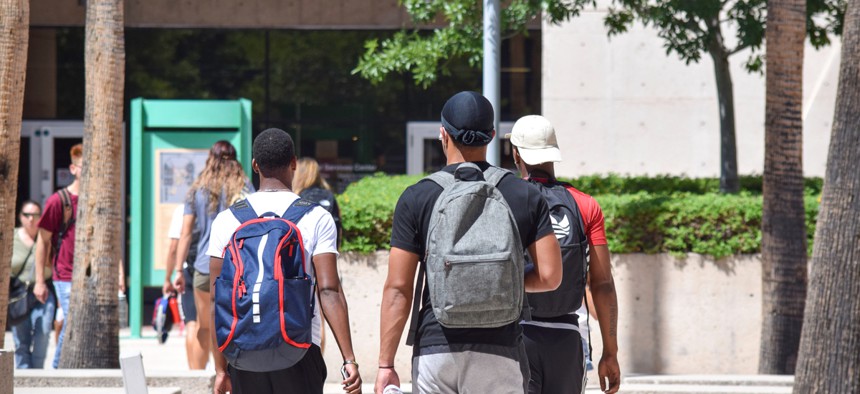A Decrease in Student Transfers Could Have Lasting Effects on Education Mobility

College students return to school at Pima Community College in Tucson, Ariz. on Aug. 27, 2018. Shutterstock
Transfers by college students decreased by 8%, with disproportionate impacts to minorities and community-college students, according to research from the National Student Clearinghouse.
Student transfers decreased by more than 8% this fall, another blow to two- and four-year colleges that have struggled to maintain enrollment numbers during the coronavirus pandemic, according to a new report from the National Student Clearinghouse Research Center.
“Transfer is an important part of student success, enabling access to bachelor's degrees for community college students, and critical opportunities for course-correction by students whose goals have changed or who need a stronger institutional fit," said Doug Shapiro, executive director of the National Student Clearinghouse, in a statement. "As the pandemic continues to constrain these avenues of institutional choice, students will face ever larger barriers to educational attainment, promising careers, and socioeconomic mobility.”
Transfers are down across all institutions, according to the report, the continuation of a trend that began before the pandemic. But the decreases are steeper this year and affect community colleges the most, as “reverse transfers”—where students at four-year colleges switch to two-year institutions—were hit hardest, decreasing by 19.4% compared to the fall of 2019. And while transfers from two-year to four-year colleges decreased slightly—by .7%—four-year schools, particularly those that are public, “show no major transfer-in student enrollment shortfalls, thanks to the relatively steady student transfers from two-year colleges amid the pandemic,” the report said.
That loss is only the latest aspect of what researchers called a “multifaceted threat” to community college enrollment, which has dropped by more than 10% since last fall. The numbers present “potentially serious implications for the sector and for the student it serves,” the report said. “If current trends continue, these divides will only grow, with a troubling risk that institutions will not survive and would-be students will not manage to come back next year.”
Transfers among students of color were also disproportionately impacted by the pandemic, according to the data. Transfer enrollment fell most sharply for Black students across all sectors, with a 22.5% drop at community colleges, a 9.2% decrease at private nonprofit four-year institutions and a 6.4% decline at public four-year colleges. Transfers among Hispanic students were increasing before the pandemic, but are now declining—by .3% at public four-year colleges, 2.6% at private four-year schools and by 20.4% at community colleges. Asian transfer students were the only group to increase at public four-year schools (4.6%) and private nonprofit four-year institutions (6.8%)—but they, too, decreased at community colleges (a drop of 16%).
There are likely multiple reasons that students are staying put, though a definitive reason is hard to discern from the data, the report said. But the transfer freeze is likely to have lasting impacts on educational mobility among multiple groups of students.
“It is not clear whether the pandemic is driving students to stay put because decision-making and administrative hurdles are more difficult to overcome without face-to-face guidance and advising, because financial and technological barriers are weighing more heavily on students and their families, or because they are simply more reluctant to risk changing institutions amid the uncertainty of the health and economic crises,” the report concludes. “As the pandemic continues to constrain these avenues of institutional choice, however, students will face ever larger barriers to degree completion, promising careers, and socioeconomic mobility.”
Kate Elizabeth Queram is a staff correspondent for Route Fifty and is based in Washington, D.C.
NEXT STORY: Where Year Two of the Pandemic Will Take Us





